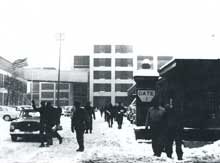It comes as no surprise that the Big Three are extending their holiday plant shutdowns this year. The great industrial drama has been playing on the news for some time now, the players dancing around bankruptcy and government mulling a rescue plan. Although the times and situations are very different, one can’t help remembering the December forty-five years ago when Studebaker announced the closing of its plants in South Bend, Indiana.
Studebaker was South Bend. Generations of families had worked in the plants, from the days of Conestoga wagons to the first electric cars to Big Sixes and Presidents and Commanders and and Starliners. Then on December 9, 1963, shortly after production of the 1964 models began, came the announcement. Production of cars and station wagons would move to Canada, and the Hawks and the striking new Avanti would be dropped. As a third-generation Studebaker worked once told me, “Bad news always came at Christmas.” He had just returned from the Army and followed in the footsteps of his father and grandfather working at South Bend’s largest employer. Then, in an instant, he was joining the ranks of the unemployed.
In the industry there were great hopes that a leaner, more efficient Studebaker could prove viable at a plant in Hamilton, Ontario. The foundries at South Bend had been shuttered and there were none at Hamilton, so engines were sourced from Chevrolet. A substantial line of passenger cars was offered, including the innovative Wagonaire and a Daytona series of upscale cars. In the end, it was all for naught, as the last Studebaker, a Cruiser four-door sedan, left the lines on March 16, 1966. Fewer than 9,000 cars had been produced for the model year.
There’s no reason to believe the Studebaker model serves as a crystal ball for the American automobile industry, that Big Three factories will never reopen. We could just as easily cite the so-called “Chrysler bailout” of 1979. In that case, government-backed loans enabled Chrysler Corporation to stay afloat and regroup. The taxpayers got their money back and then some, because the Mopar folks had a couple of hit products, the incredibly useful minivan and a trendy line of trucks. Even if the Big Three are exiled into bankruptcy and meet their demise it will not spell the end of the American auto industry. Foreign-owned plants, mostly in the South, will continue to build cars – very soon we expect to be driving one. Regardless of what happens in Detroit, some remnant of General Motors will probably still be building Buicks in China for many years to come. It is safe to say, however, that the American auto industry we knew will look quite different before 2009 is over.

